Jan Kaplický facts for kids
Quick facts for kids
Jan Kaplický
|
|
|---|---|
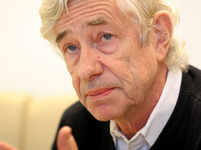 |
|
| Born | 18 April 1937 |
| Died | 14 January 2009 (aged 71) Prague, Czech Republic
|
| Occupation | Architect |
| Awards | Stirling Prize (1999); World Architecture Awards (2001), Royal Institute of British Architects Award for Architecture (2004) |
| Practice | Future Systems |
| Buildings | Media Centre, Lord's Cricket Ground, London (1999) Selfridges Building, the Bull Ring, Birmingham (2003) |
| Projects | National Library of the Czech Republic, Prague, Czech Republic (commission awarded 2007, cancelled 2008) |
| Design | Neo-Futurism |
Jan Kaplický (born 18 April 1937 – died 14 January 2009) was a famous Czech architect. He spent much of his life in the United Kingdom. He was known for his unique style called Neofuturism. He led an innovative design company called Future Systems.
Kaplický is best known for two amazing buildings: the Selfridges Building in Birmingham, England, and the Media Centre at Lord's Cricket Ground in London.
Contents
Early Life and Moving to London
Jan Kaplický was born in Prague, Czechoslovakia (now the Czech Republic) on 18 April 1937. He was the only child of a sculptor and an artist who drew plants. He grew up in a suburb of Prague called Ořechovka.
From 1956 to 1962, he studied architecture in Prague. After finishing his studies, he worked as an architect in Czechoslovakia. In 1968, when the Soviet army invaded Czechoslovakia, he left for London. He arrived with only $100 and a few pairs of socks. In London, he met Eva Jiřičná, another architect he knew from Prague.
Building a Career
In England, Kaplický worked for several well-known architects. He worked with Renzo Piano and Richard Rogers from 1971 to 1973. During this time, he helped design the famous Centre Georges Pompidou in Paris. Later, he also worked for Foster and Partners.
Future Systems: A New Style
In 1979, Jan Kaplický started his own architectural company called Future Systems with David Nixon. They wanted to create a new kind of architecture. Their designs often looked like organic shapes or futuristic machines.
Kaplický believed buildings didn't have to be boring boxes. He once said, "Where is it written that buildings have to be boxes? People aren't boxes." He designed things like houses that looked like survival capsules and structures that could orbit the Earth.
In 1989, Amanda Levete joined Future Systems as a partner. She and Kaplický married in 1991 and had a son named Josef. Even after they divorced in 2006, they continued to work together at Future Systems.
Famous Buildings and Awards
For many years, Future Systems didn't get many big projects. But in 1994, they were chosen to build the new Media Centre at Lord's Cricket Ground in London. This building was a huge success! It won the Stirling Prize in 1999, which is a very important architecture award in the UK. It also won the World Architecture Awards in 2001. Kaplický loved this building, calling it "my favourite creation."
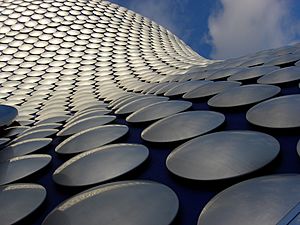
Future Systems' next big project was the amazing Selfridges Building in the Bull Ring in Birmingham. This building, with its unique bubble-like design, won seven awards, including the RIBA Award for Architecture in 2004.
The "Octopus" Library Project
In 2007, Kaplický won a competition to design a new National Library building in his home country, the Czech Republic. He said this project was the most important event in his life. However, his design, which looked like a green and purple blob and was nicknamed "the Octopus," faced a lot of criticism.
Some people, including the President of the Czech Republic, did not like the design. The Mayor of Prague also changed his mind and decided against it. Even though the design was eventually cancelled, Kaplický still hoped the building would be built one day with private funding.
Teaching and Later Life
Besides designing buildings, Kaplický also taught architecture. He taught at the Architectural Association School of Architecture in London and other universities in Europe.
Towards the end of his life, Kaplický spent more time in the Czech Republic. He was waiting for the National Library project to start and had another design approved for a Congress and Concert Hall Centre in České Budějovice.
In 2007, he married film producer Eliška Fuchsová. On 14 January 2009, just hours after his daughter Johanna was born, Jan Kaplický sadly collapsed in Prague and passed away. The city of České Budějovice has said they are determined to build his design there to honor him.
Kaplický believed that creativity is everywhere. He said, "The world is full of beautiful things, and you have to be observant as an architect." He also thought that personal happiness could be seen in an architect's work.
Major Architectural Projects
| Image | Information | Awards |
|---|---|---|
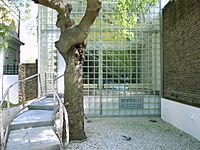 |
Hauer-King House |
|
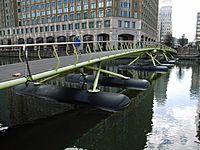 |
West India Quay Bridge |
|
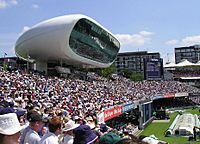 |
Media Centre, Lord's Cricket Ground |
|
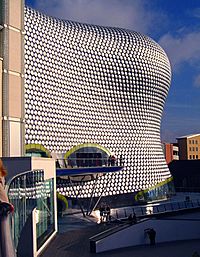 |
Selfridges Building |
|
|
Naples Subway Station |
||
 |
Museo Casa Enzo Ferrari |
|
|
National Library of the Czech Republic |
||
|
Congress and Concert Hall Centre |
See also
 In Spanish: Jan Kaplický para niños
In Spanish: Jan Kaplický para niños


